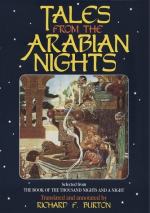[FN#46] Our Arabian Ulysses had probably left a Penelope or two at home and finds a Calypso in this Ogygia. His modesty at the mention of womankind is notable.
[FN#47] These are the commonplaces of Moslem consolation on such occasions: the artistic part is their contrast with the unfortunate widower’s prospect.
[FN#48] Lit. “a margin of stone, like the curb-stone of a well.”
[FN#49] I am not aware that this vivisepulture of the widower is the custom of any race, but the fable would be readily suggested by the Sati (Suttee)-rite of the Hindus. Simple vivisepulture was and is practised by many people.
[FN#50] Because she was weaker than a man. The Bresl. Edit. however, has “a gugglet of water and five scones.”
[FN#51] The confession is made with true Eastern sang-froid and probably none of the hearers “disapproved” of the murders which saved the speaker’s life.
[FN#52] This tale is evidently taken from the escape of Aristomenes the Messenian from the pit into which he had been thrown, a fox being his guide. The Arabs in an early day were eager students of Greek literature. Hole (p. 140) noted the coincidence.
[FN#53] Bresl. Edit. “Khwajah,” our “Howajee,” meaning a schoolmaster, a man of letters, a gentleman.
[FN#54] And he does repeat at full length what the hearers must have known right well. I abridge.
[FN#55] Island of the Bell (Arab. “Nakus"=a wooden gong used by Christians but forbidden to Moslems). “Kala” is written “Kela,” “Kullah” and a variety of ways. Baron Walckenaer places it at Keydah in the Malay peninsula opposite Sumatra. Renaudot identifies it with Calabar, “somewhere about the point of Malabar.”
[FN#56] Islands, because Arab cosmographers love to place their speciosa miracula in such places.
[FN#57] Like the companions of Ulysses who ate the sacred oxen (Od. xii.).
[FN#58] So the enormous kingfisher of Lucian’s True History (lib. ii.).
[FN#59] This tale is borrowed from Ibn Al-Wardi, who adds that the greybeards awoke in the morning after eating the young Rukh with black hair which never turned white. The same legend is recounted by Al-Dimiri (ob. A.H. 808=1405-6) who was translated into Latin by Bochart (Hierozoicon ii. p. 854) and quoted by Hole and Lane (iii. 103). An excellent study of Marco Polo’s Rukh was made by my learned friend the late Prof. G. G. Bianconi of Bologna, “Dell’Uccello Ruc,” Bologna, Gamberini, 1868. Prof. Bianconi predicted that other giant birds would be found in Madagascar on the East African Coast opposite; but he died before hearing of Hildebrand’s discovery.
[FN#60] Arab. “Izar,” the earliest garb of Eastern man; and, as such preserved in the Meccan pilgrimage. The “waist-cloth” is either tucked in or kept in place by a girdle.
[FN#61] Arab. “Lif,” a succedaneum for the unclean sponge, not unknown in the “Turkish Baths” of London.




